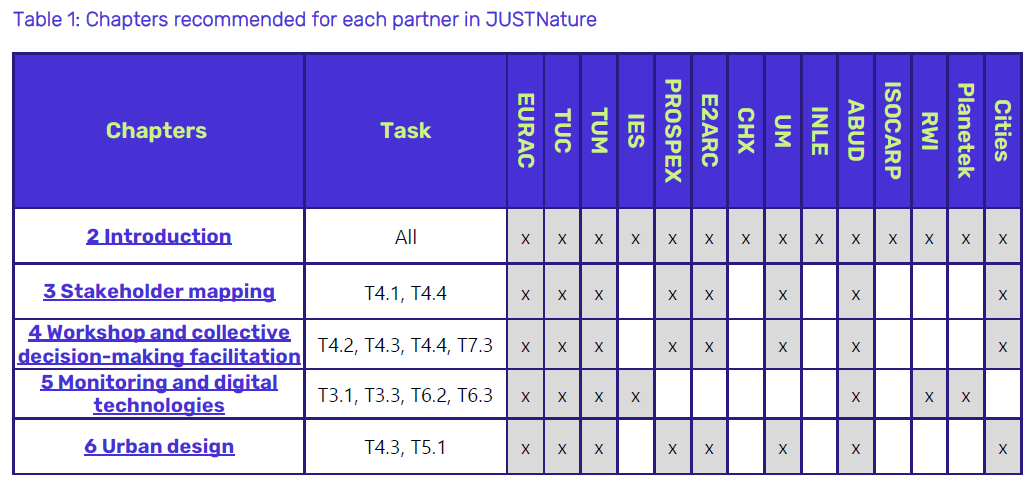The deliverable 1.4, Gender Guidelines, was submitted by ABUD with contributions from Eurac Research, PI, TUM, TUC in June 2023. The description of the deliverable is available below and the full deliverable is at the end for download:
"Gender empowerment is a key aspect to consider in the just development of Low Carbon | High Air Quality Nature-based Solutions (NbS). In most societies women are more disadvantaged than men, having less access to resources, decision-making and power (Lorber, 2010). Moreover, as a result of the lower income and perceived lower social status of women, they tend to bear inequitable environmental burdens and have less control over environmental decisions as opposed to men, which both have an impact on their health (Bell, 2016). The aim of this document is to contribute to reducing the inequalities with that women face, within the scope of JUSTNature, by means of gender guidelines.
After introducing key concepts and definitions, Chapter 1 briefly presents the gender empowerment task of JUSTNature project (T1.6) and explains how the gender guidelines are situated within it. Four key fields of action are identified and justified: (1) trainings and guidance, (2) gender analysis, (3) gender sensitive design, and (4) gender evaluation.
Chapters 3-6 contain the gender guidelines, which are practical recommendations for reducing gender inequalities in different tasks of JUSTNature. Each guideline contains the list of responsible partners, describes the relevance of the guideline, and gives recommendations for practical activities supporting gender empowerment. Additionally, in each guideline, there is a checklist for monitoring the implementation of the recommendations.
Chapter 2 covering gender-sensitive stakeholder mapping aims to help the project partners implement the stakeholder mapping activity in T4.1 and power mapping in T4.4 in a gender-sensitive way, ensuring representation and directing attention to gendered power relations. The guideline highlights the importance of gender-disaggregated data collection and gender quota and gives recommendations for how intersectionality and gendered power relations can be addressed during the stakeholder mapping activity.
Chapter 3 covering gender-sensitive workshop and decision-making facilitation is about the basic principles of gender sensitive participatory process management. It is to be applied both to access and quality of participation in workshops (T4.2-4), as well as collective decision-making in co-governance (T7.3). The guideline targets the facilitation team organizing workshops with local stakeholders. It contains recommendations for the whole participatory process, i.e., required skills of facilitators, successful engagement techniques, gender sensitive moderation and communication, and evaluation of the workshops.
Chapter 4 covering monitoring and digital technologies aims at supporting developer tasks to critically reflect on gender relations in the context of digitalization and to ensure that a digital gender empowerment occurs as a result of JUSTNature. It highlights aspects to be considered in the development of indicator framework (T3.1), decision-support tools (T3.3), digital twin (T6.2) and governance platform (T6.3). It covers a wide variety of topics, including gendered digital divides, non-neutral technology, gender-sensitive monitoring, A.I. governance, and gender bias.
Chapter 5 is a training material for presenting gender sensitive urban design solutions on workshops with local stakeholders (T4.3, T5.1). As part of the gender empowerment task, a gender-sensitive urban design portfolio was developed, which will be presented for the consortium on the 1st CiPeL meeting and will be used by the facilitation team on one of the workshops with local stakeholders. This training material is prepared in support of the facilitation team, and it will be presented to them as part of a training dedicated to gender sensitivity. The portfolio is a source of inspiration, based on which a discussion and brainstorming can be started with local stakeholders. The portfolio contains best practices for accessible design, public space security, gender-sensitive affordances and the representation of women in public art and public space elements.
The following table gives guidance on which organization should read which chapter. Note that it is highly recommended to everyone reading the introduction, as it contains key concepts and definitions. By clicking on the titles of chapters in the table, the reader can jump on the selected chapter.
